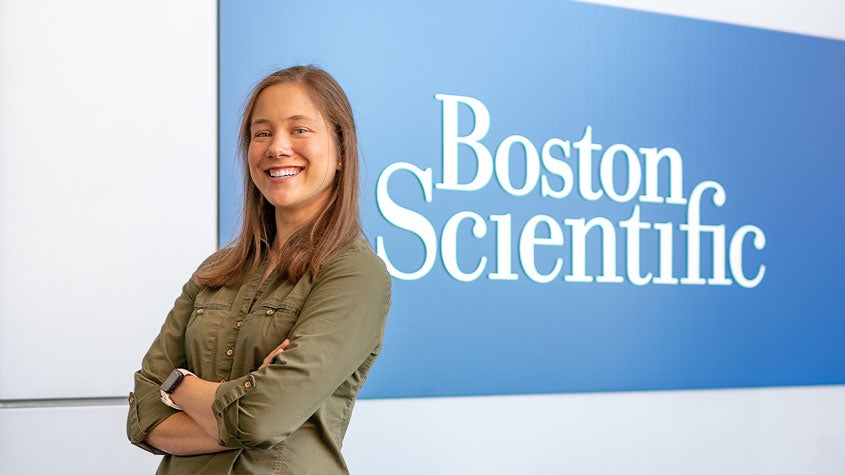On any given day, you might find her running on one of the many trails around Minneapolis. As a research and development engineer for Boston Scientific, Brooks serves on the front line in the creation of medical devices designed to improve the quality of life for patients around the world.
“My undergraduate degree taught me how to think like an engineer; my master’s degree taught me how to think like an innovator,” said Brooks, who received a bachelor of science in bioengineering from Rice in 2016 and a master of bioengineering in 2018 as part of Rice's Engineering Professional Master's Programs.
Brooks’ time at Rice’s Global Medical Innovation program (GMI) prepared her for world-class R&D engineering endeavors in the cutting-edge medical device industry by offering her a global perspective through a project-based curriculum.
“I’ve known about GMI since its inception my senior year at Rice,” Brooks said. “Immediately I was drawn to the program. I was especially drawn to the internship and international collaboration in Costa Rica and Brazil.
“GMI provides a unique, hands-on practical focus on innovation and the medical device industry.”
Brooks said prior to applying to GMI, she spent a year conducting research in Germany through the Whitaker Fellowship after receiving her bachelor’s in bioengineering. Once she began the GMI program, she learned that her colleagues would be more akin to teammates, whose common goal was the betterment of humanity.
“The ‘GMIers’ are a tight-knit group,” she said. “From late nights working on projects in the OEDK to traveling to Costa Rica and conferences together, I have fond memories. I’ll especially remember visiting the hospital in Costa Rica, seeing the dialysis patients we’d be helping with our project and speaking with the physicians.”
The Oshman Engineering Design Kitchen offers students a 20,000-square foot design studio providing all the necessary elements for the development of engineering design projects—projects that often find their way into real-life applications.
Rice’s collaboration with the Texas Medical Center delivers experiential learning opportunities, allowing GMI participants to assist in the development of pioneering solutions to real-world problems, partnering with a major metropolitan medical community that serves more than 10 million patients every year.
“[GMI] leverages numerous unique resources in the Houston medical center—from partnering with physicians and observing in the OR to being exposed to medical device startups through TMCx and JLABS,” said Brooks. “Through the international projects, you learn not only how to apply your engineering skills throughout the development process, but also how to collaborate in this global economy. I use these skills every day in my role as an R&D engineer.”
Brooks’s role at Boston Scientific doesn’t just involve working with cool gadgets and machinery to develop awesome medical devices, it includes working with the people whose lives the devices will change so that she can better understand their needs.
“While at work, I often apply the design principles that we learned during GMI,” said Brooks. “The beginning of the design process starts with understanding the user needs. I’ve had the opportunity to develop voice of the customer and speak with patients who have our products. I’ve also been able to prototype and test concepts back in the lab.”
It’s truly the whole package that makes Brooks a well-rounded engineering professional. Her passion for her profession extends beyond her job-specific responsibilities.
“I enjoy the challenge that comes with working on the development of a new medical device,” said Brooks. “Multiple elements and inputs must be synthesized into one final product. For example, we must consider not only design requirements but also regulatory factors and manufacturability. I enjoy working cross-functionally with everyone from process development to marketing in my role.”
While some high school-aged kids were planning careers in professional video gaming, Brooks was daydreaming of tissue engineering and biomaterials.
“I’ve known since high school that I wanted to be a biomedical engineer,” said Brooks. She adds, however, that biomedical engineering is a broad field.
“The path that I took to find my current occupation in medical device R&D was a winding one," Brooks said. Despite my decision in high school to become a biomedical engineer, I did not fully understand what a biomedical engineer did—the breadth of the field. There is biotech and medtech. Bioengineers might specialize in tissue engineering or mechanics, cellular engineering or electronics.”
Brooks said she used her undergraduate career at Rice as an opportunity to explore the field, initially pursuing tissue engineering.
“I conducted research in a number of labs and thought I would pursue my Ph.D.," she said. "However, I came to realize that a career in the lab and in an academic setting was not what I wanted. Throughout my undergraduate years, my focus shifted. I had multiple opportunities to innovate and design and that’s when I decided I wanted to pursue medical devices. I wanted to work in an industry developing products that improved people’s quality of life.”
This biomedical engineer and part-time distance runner knows a thing or two about the long run. For new graduates entering the workforce, her advice may be surprising.
“If you don’t know exactly what you want to do upon graduation or what different career paths entail, network,” she said. “Talk to people about their jobs. Also, try to gain a multitude of experiences.”

